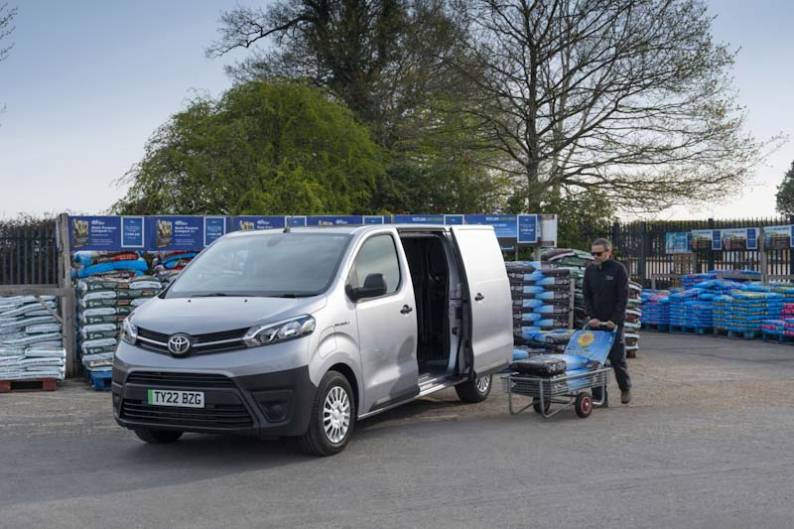
RAC sale – up to 33% off*
• Roadside cover from £5.29 a month†
• We get to most breakdowns in 60 mins or less
• Our patrols fix 4/5 breakdowns on the spot

Toyota's Proace City Electric offers businesses looking to make the EV switch a small van with peace of mind. Jonathan Crouch sees how it measures up.
Ten Second Review
Toyota's Proace City Electric is a small van with big ideas for the environment. Like all full battery-powered LCV's, it looks a bit pricey but you get a longer warranty than any other van in the class, a useful 'Smart Cargo' loading system and a usable 186 mile driving range between charges.
Background
With its hybrid technology, Toyota has played a major role in vehicle electrification in the 21st century. So who could have thought that the brand's very first full-EV products would be vans - with engineering developed by someone else. Yet that's just what we got as the company was dragging its feet getting the all-electric bZ4X SUV into production. First the Proace Electric mid-sized van; then this LCV, the Proace City Electric. Both are based on the Stellantis (formally PSA Group) engineering of similar vans already on sale from Peugeot, Citroen and Vauxhall: namely the Peugeot e-Partner, Citroen's e-Berlingo and the Vauxhall Combo-e.
You might worry here about a slightly smaller dealer network than those other manufacturers can provide, but the number of 'Toyota Professional' van outlets is growing - it's over 140 now. And this Proace City Electric offers a warranty of up to 10 years that it's close cousins can't match. Sounds promising.
Driving Experience
If you know anything about the engineering of this product, you won't be expecting it to be any different to drive than its e-Partner, e-Berlingo or Combo Cargo-e EV cousins - and of course, it isn't. Start up and there's the usual beep as you get the sign that all is ready to pull away; which you do in the default 'Normal' drive mode. The other selectable drive settings are 'Eco' and 'Power'. You'll need the 'Power' mode to unleash the electric motor's full 134bhp output, though if you drive like that, you will of course get nowhere near the 50kWh battery's WLTP-rated best driving range figure of up to 168 miles. Better to stick to the 'Normal' mode, which restricts output to 108bhp; or possibly around town to 'Eco' mode, though that gives you just 81bhp and restricts the climate system. 'Normal' mode should be fine for realistic maximisation of range, particularly if you select the 'B' transmission setting that increases brake regeneration.
As usual with EVs, if you do need performance, it's only a right foot jab away; 62mph from rest occupies 11.2s, but the instant response you get to 30mph makes this LCV feel quicker than that. Overtakes are easy too; 50-75 mph takes 8.9s.
Design and Build
Unless you happen to notice the badging or the charging flap, there's little to set this EV van apart from any other Proace City model. As in the combustion range, there's a choice of standard or long wheelbase body styles, which both have sliding doors on each side. At first glance, the cab doesn't seem much different either, but closer inspection reveals different instrumentation and an e-Toggle drive mode selector in place of the gearshift. The drive modes are selected by a switch alongside.
Toyota has chosen the conventional interior layout used by the Combo Cargo-e and the e-Berlingo, rather than the e-Partner's weirder 'i-Cockpit' set-up with its small steering wheel and high set dials. Thanks to the standard 'Smart Cargo System', as on the ordinary model, the passenger seat back folds down to create a desk surface. And there's an 8-inch centre touchscreen with 'Apple CarPlay' and 'Android Auto' smartphone-mirroring. Plus a 3.5-inch multi-information display in the instrument binnacle. None of this is of Toyota design, but it's all pretty functional and the Japanese brand's graphics do at least feature on the centre touchscreen. There is no lack of storage space in the cab: 16 storage points according to Toyota, these including a 15-litre area in the centre console.
Market and Model
After deduction of the available £2,500 Plug-in van grant, Toyota wants around £30,500 from you for this Proace City Electric, that's after your business has reclaimed the VAT. That's for the short wheelbase version with the base 7kW on-board charger. A few hundred pounds more gets you the gutsier 11kW on-board charger for quick battery replenishment. It's probably worth stretching to the long wheelbase Long variant, which only costs around £700 more.
There's only one level of trim - 'Icon' - but it includes quite a lot. You can tick off auto headlamps and wipers, twin sliding side doors, cruise control and an 8-inch centre infotainment touchscreen with 'Apple CarPlay' and 'Android Auto' smartphone-mirroring. You also get cruise control, a colour 3.5-inch multi-information instrument binnacle display, Bluetooth, a DAB audio system and door mirrors that are heated and power adjustable. And Toyota includes its 'Smart Cargo' system which allows you to push through items from the cargo bay into the cab and fold down the passenger seat to create a handy table. There are two USB ports in the cab and your dealer will offer you accessories like rubber floor mats and ply lining for the load space.
Practicalities and Costs
Potential customers will be pleased to learn that the EV powertrain doesn't compromise practicality. Total capacity depends on your choice between standard L1 (4.4-metres long) and long L2 (4.75-metres long) body styles. There's the usual side-opening siding door and twin side-hinged rear doors that open to 180 degrees. The L1 offers 3,090mm of cargo area load length, with a maximum load height of 1,200mm and a maximum load width between the wheel arches of 1,229mm. The L2 offers 3,440mm of cargo area load length. Yet more space can be freed up with the clever 'Smart Cargo' feature. This uses a folding front passenger bench to add an extra 0.4m3, while also increasing the maximum load length by 1.3m. Maximum load volume including the 'Smart Cargo' system on the L1 is 3.8m3; on the L2, it's 4.4m3. The maximum payload of the L1 is up to 803kg - or up to 751kg for the L2. Both have a towing capacity of up to 750kg.
All Proace City vans are covered by the 'Toyota Relax' programme simply by having servicing done at an authorised Toyota centre. If you do that, after the end of the five year/100,000 mile warranty you'll gain an extra year and 10,000 miles of cover up to a limit of the vehicle reaching 10 years and/or 100,000 miles. That's much better than you'd get from this model's close EV cousins.
Summary
You've still got to do quite a few careful sums to justify the purchase of an electric van these days, even with the benefit of the available government grant. But if you can make the figures add up and you need one of a more compact size, then this Proace City Electric certainly deserves to be on your list.
It's major selling point over its identically-engineered LCV Peugeot, Citroen and Vauxhall cousins, as we've been saying in this review, lies in its longer warranty. If that appeals and you've a 'Toyota Professional' van dealership in easy reach, then the only other decision you've to make is whether this model makes more sense than the other major class player, the Renault Kangoo E-TECH. That extra back-up makes this Proace City model look good here too. We still can't help wondering what a future fully Toyota-engineered van of this sort might be like. But for the time being, this one will do just fine.





![Toyota Prius Plug-In Hybrid [XW50] (2017 - 2022) used car review](https://d1ix0byejyn2u7.cloudfront.net/drive/images/made/drive/images/remote/https_d2yv47kjv2gmpz.cloudfront.net/filestore/0/5/8_bc3ee98df27564c/41cb89f9810c870b2ee11e03aec84bff/850_8d93a7aee7f823d_100_100_70_c1_c_c.jpg)

